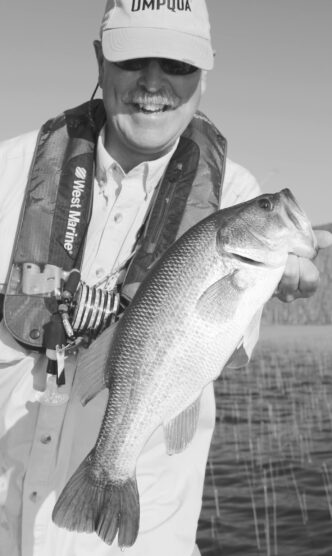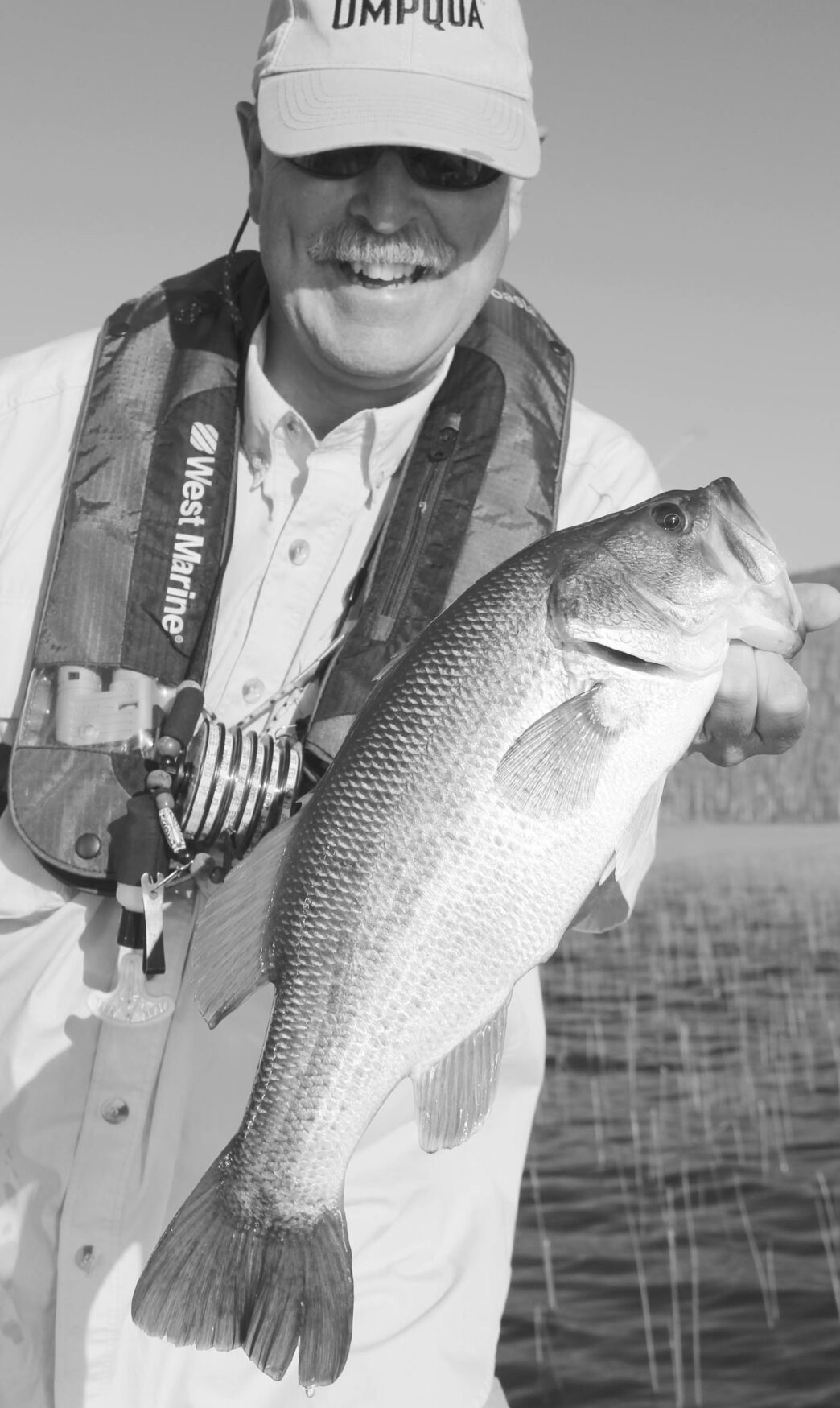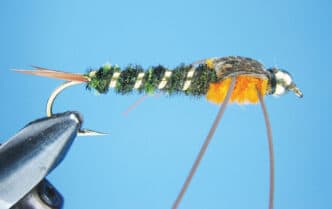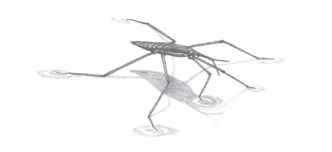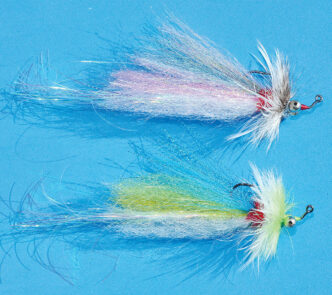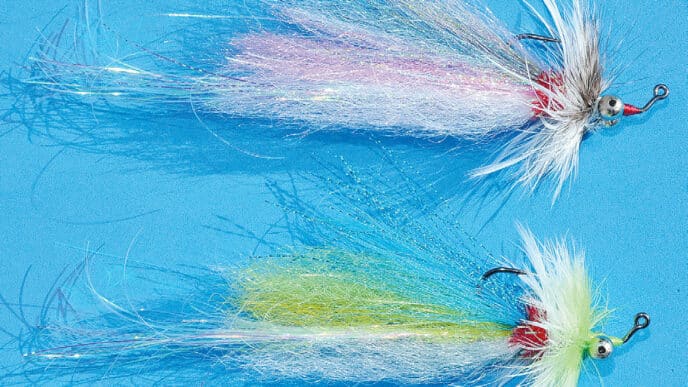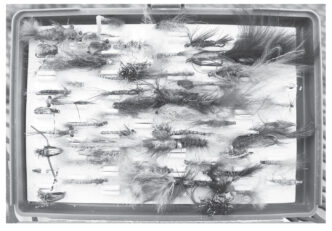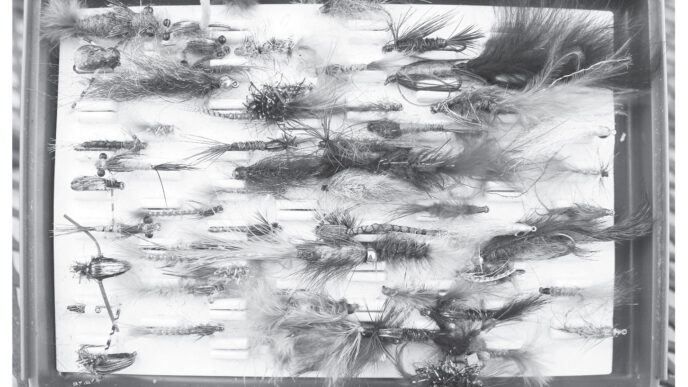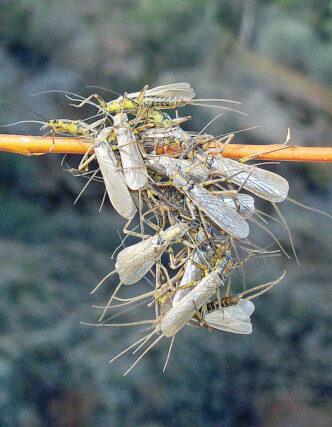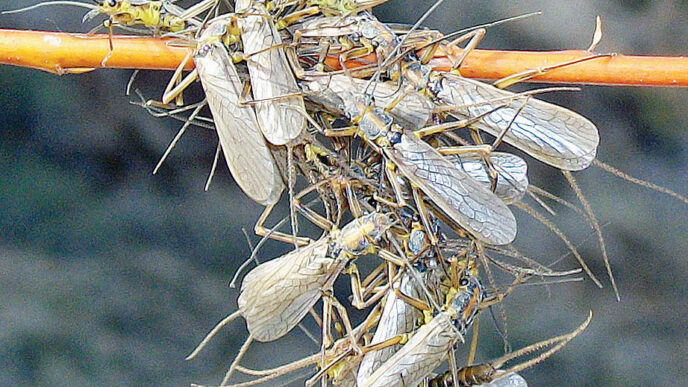I prefer catching largemouth and smallmouth bass on top-water flies, and I pursue this challenge throughout the season. But I like to be prepared to fish subsurface, too, and I’ve put a safety clip and several Velcro strips into the lateral D rings of my float tube so that in addition to a rod that is rigged with a floating line and a bass bug, I can carry another with a floating line and a sinking bass fly at the end of a 9-foot or 10-foot fluorocarbon leader. I have even thought about carrying yet another rod with a sink tip line, but it’s harder to keep everything orderly, and I’ve found that I don’t need it on local ponds and the lakes I fish near my Sierra foothill home.
Although I fish top-water flies two-thirds of the time, conditions this past spring made me fish subsurface flies more often. The winter was warmer than usual, and that brought fish inshore by mid-February, and then a heavy rainfall delivered five inches or so of precipitation in a week’s period. It was the season’s salvation, but it also resulted in stained, muddy water that persisted into early April. In addition, I wasn’t catching many top-water fish, and an angling friend was tearing them up on conventional tackle using accurate inshore casting and specialized drop-shotting techniques in which an artificial bait is cast tight to structure with a sinker below it on the line, not above it. So rigged, the lure sinks quickly to near the bottom, and then is fished as if it were weightless. With the weight on the bottom, not between the angler and the lure, it’s a lot easier for the conventional-tackle angler to identify a subtle take.
I fished with my friend off his bass boat several times and was amazed and humbled by his success. The fish were there on structure that consists of rock and cement walls, docks, rocks, overhanging brush, and shoreline transitions. He was taking and releasing 12 to 15 fish or more in a session, and I was getting 3 or 4, if that. I wasn’t feeling the grab very well, and my flies weren’t as interesting to the bass as his Smallie Beaver baits. These soft plastic baits by Reaction Innovations were enhanced with his drop-shotting techniques, which imparted an enticing action, and perhaps by their scent or taste, as well. I’ve done the taste test on these baits, and they are very salty, almost like popcorn butter.
I have another angling friend who refuses to fish under indicators when trout fishing, even when he is being seriously outfished, but I’m not that proud. I took up my friend’s offer to try a drop-shotting rod, and I’ve since purchased one. I wanted to become proficient with this equipment and thought I could incorporate some of the key points of his technique in my subsurface fly-rod bass fishing. I was right. Here’s how I did it.
I put away my 7-foot 11-inch largemouth fly rod and started fishing with a 9-foot 8-weight high-modulus graphite saltwater fly rod, lined with a 290-grain bass taper floating line. The line allows me to detect takes better and the rod’s length helps on a hook set out of a float tube.
I felt that I needed to mate my fly with a better line-leader setup. I wanted a controlled sink rate . . . not too fast, not too slow, with the fly and leader sinking at a similar rate, avoiding an exaggerated vertical arc that would make detection of a strike difficult. With an aggressive floating bass taper that could be mended as needed, I wanted to keep the fly, leader, and rod and line in as straight a line as possible.
A friend of mine uses 8-pound or 10-pound-test fluorocarbon fishing line. Fluorocarbon is less visible underwater, stretches less, sinks faster than nylon, and is more abrasion resistant. I went up to 15pound-text fluorocarbon tippets, though, because I wanted something even stronger. Standing on the elevated front deck of his stable bass boat, my friend is quick and vigorous in setting up on anything that seems remotely like a subsurface take. I needed to do the same, but out of a lower and less stable float tube without fear of leader breakage on the set, as well as needing to be able to put the brakes on if a fish turned back toward its sanctuary.
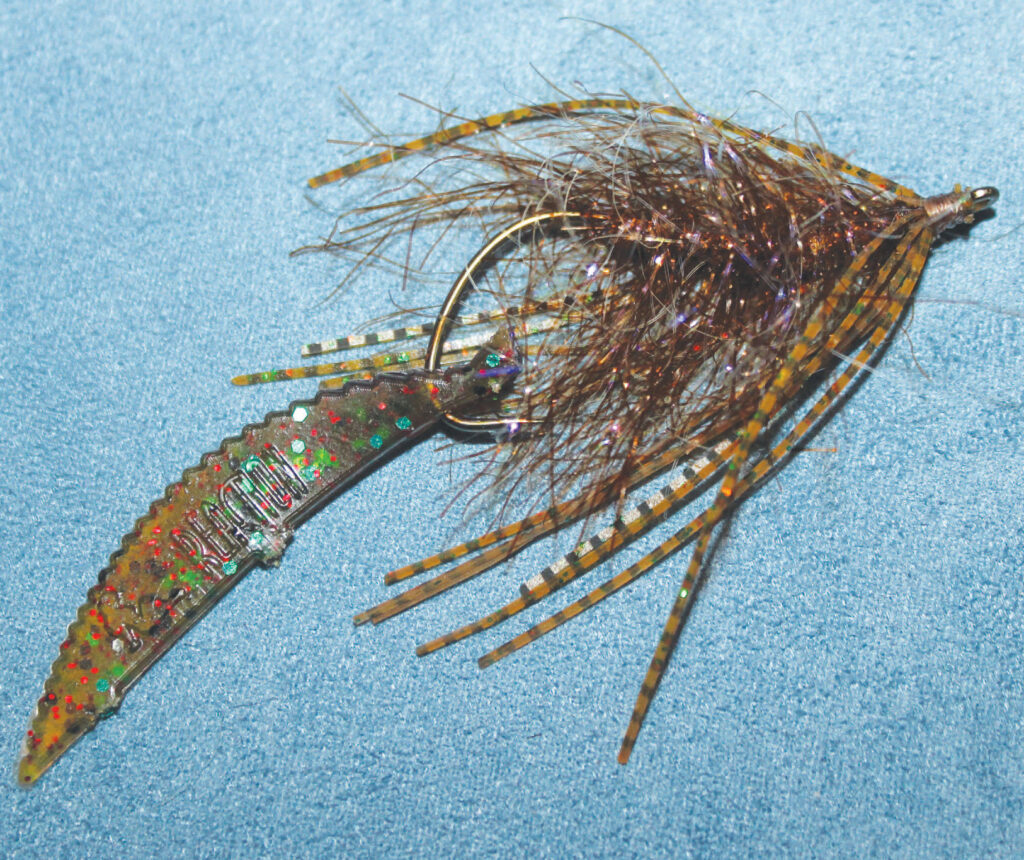
Detecting the strike when fishing subsurface flies for bass is largely a matter of mental focus. When a large bass hits a top-water bug, there’s time to set the hook. If you strike too quickly, you can miss the hook set. Daydreaming or when I’ve turned to wave to someone in a boat, I’ve had times when I’ve heard fish blow up on my popper. You can strike late when that happens and still hook up. With subsurface flies, though, bass may take in a more delicate fashion, and you need to be attentive. At times, they will pick up a fly or bait and move it away from their nesting area, then drop it. You may never feel any resistance. So an angler needs to set the hook on anything that is even suggestive of a touch. You have to stare down your line and leader and visualize that subsurface fly. It’s good to block out all outside distraction and put yourself in a trance-like state. Around docks, pilings, or walls, bass will take a fly that has tumbled about two-thirds of the way or more to the lake floor. We call this “taking on the fall.” Anticipate that impending grab and be ready.
Another action point is when the fly gets to the bottom. Fish take there and on the pause between the first several pulls of your retrieve. If you aren’t detecting fish, go on a hunch and try striking when you think the fly is in the zone. You might just be right.
Vary your angle of attack. Don’t always cast straight in and perpendicular to the shore. Try casting in at a 45-degree angle, or move farther inshore and cast parallel to the bank, always retrieving with your rod tip in the water and in as straight a line as possible. Vary the angle at which you cast to a dock, too — not just straight in along the edge and out. Often I will throw onto a dock, beyond a wall, or onto a steep shoreline bank and gently pull my fly over the lip and let it fall into the water. Fish orient to the sound of a fly hitting the dock structure and to the plop and a natural sink. That’s one reason I don’t want my fly to be too heavy. Be ready.
Experienced bass anglers will tell you that they set on “lack of resistance.” Sometimes there’s just a vacuum of sorts. Line, leader, and fly have a natural resistance in the water that depends on line diameter, fly bulk, and retrieve speed. When there is an absence of resistance, something has happened. Strike. If your rod, line, and leader are lined up straight, with minimal horizontal or vertical arc, you can strip set in saltwater angling style by throwing your line-control hand in one direction and you rod hand in the other, like a great heron flapping its wings outward. More often than not, you will tie into more fish than by just lifting your rod vertically or sweeping it to the right or left. Let the strip set flow into the sweep.
An inshore bass will often take a fly and come right at you or move to the left or right, holding the fly in its mouth all the time, without you feeling or seeing anything. Your brain suddenly realizes that there must be a reason why your line is starting to arc. And even if the bass is running and seems to be hooked, don’t forget to hammer that fish and set the hook. Unless you do so, the fly will likely pull out on the first jump.
If I take a fish inshore, I want to know what the water depth was where the fish hit. Some fish like deeper water at the end of a dock, others the security of a piling shadow or the overhang of a dock eave. Try to discern a pattern and repeat success. Like successful trout anglers working in clear, still water, successful bass anglers finessing structure remember everything about what worked and then milk that cow over and over. In a float tube, I kick in and measure with a rod dipped vertically. It will tell me how deep the water was where my fish took, which piling of a dock to throw to on my next visit, or how long to let my fly fall. Nine times out of 10, it will be on the shady side of any structure. Try to identify a pattern and repeat it, over and over.
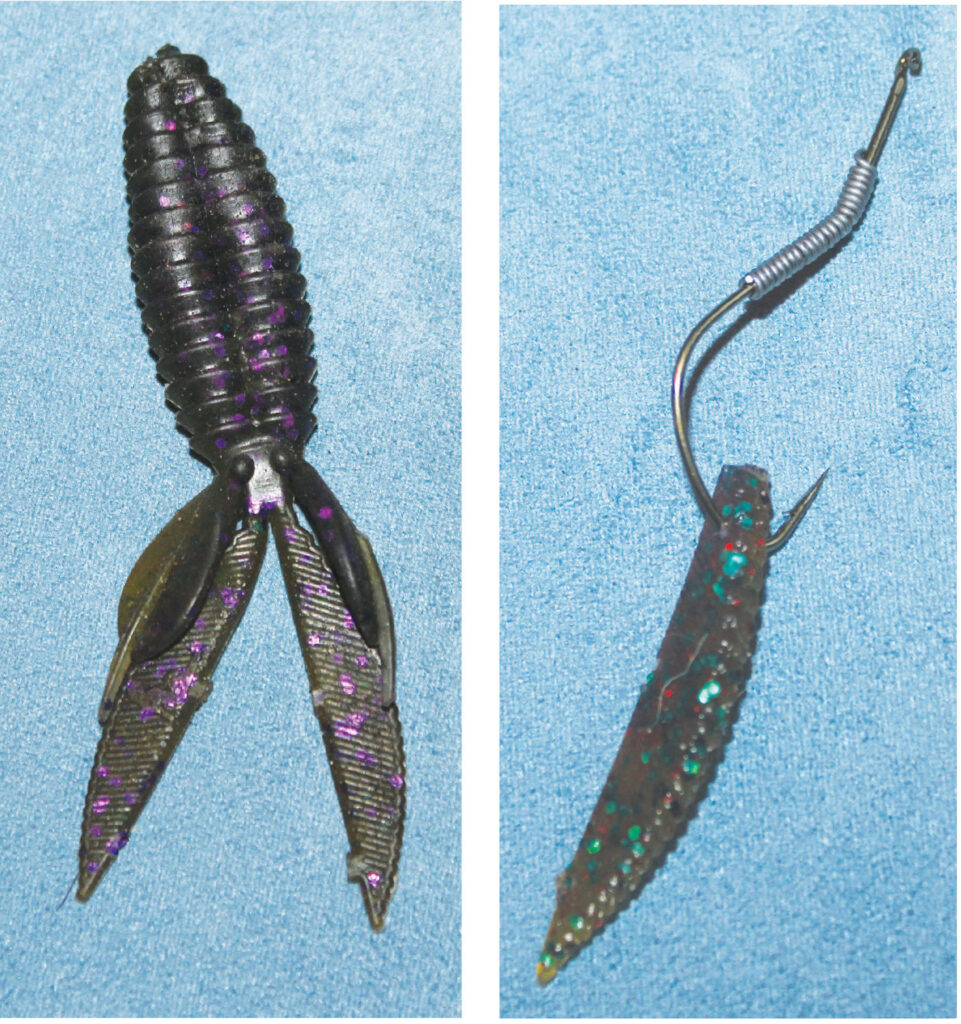
The business end of the rig that I have described is your fly. When adapting drop-shotting techniques for the fly rod, the weighting and action of that fly are just as important as the other components. I’ve had success for a few years using my version of the Calcasieu Pig Boat that was first tied by Tom Nixon in Louisiana in the 1950s. I wanted an interesting, larger fly that would push water, undulate and vibrate with the slightest animation, not take all day to reach depth, yet not sink too fast. For action, I add a trailer that is impaled on the hook bend. The best materials are a mink strip or pine squirrel strip that can be impaled or tied into the fly itself. They don’t get as waterlogged as rabbit strips. Better than that is a twister or pork-rind frog imitation made from thin latex dental dam material. The ultimate and most successful trailer, however, is one made from one of my friend’s Smallie Beaver plastic baits. I take the chewed-up ones that retain some of the scent of the fish they caught, then use serrated scissors to cut thin strips two to three inches long that I impale on the hook shank. Bass will chomp down and not let go. I tie the fly in all black, in chartreuse and white, and in crawdad orange and brown using large palmered brown UV Polar Chenille for the body material and thin rubber jig or leg material, solid or variegated, to form a 12-strand hackle collar, six strands on top and six on the bottom, just behind the hook eye. It extends back beyond the hook bend. My best guess is that it is imitating a crawdad.
The crawdad-brown-and-orange version seemed to work best, so I’ve concentrated on it and fished it all season, modifying it as I went forward. I bent my Daiichi 5/0 2720 popper hook shank halfway between the start of the bend and the eye to create the old “keel” fly look. I also opened the gap a bit and wrapped 25 turns of 25-amp lead wire, with 15 turns beyond my bend toward the hook point to lower the center of gravity and make the fly ride hook-up and be weedless. Ten more turns of the lead continued from my added bend toward the hook eye. My goal was to have a relatively weed-free fly that could be worked down a sloping bank with a slow retrieve that incorporating lots of pauses. I wanted my fly to sink at a medium rate, not getting excessively ahead of my leader, then stay down near the bottom. I’ve also been tying the fly on a Gamakatsu 5/0 07111 offset-shank worm hook with the same 25 turns of lead on the front part of the hook shank. It seems to work. I will be doing more testing on this promising hook as we move into the fall season.
By press time, our bass will be foraging inshore once more. They aren’t driven by reproductive urges, as in the spring, but are looking for food as inshore water temperatures drop and weed buildup starts to diminish. Winter is approaching. The techniques that improved my success rates fishing subsurface flies for bass this spring and early summer will pay off as we move into another season and a productive time of the year.



